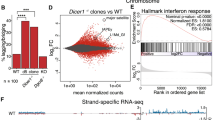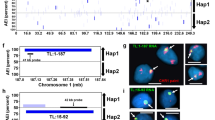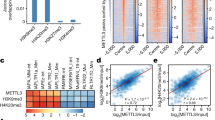Abstract
Dicer initiates RNA interference by generating small RNAs involved in various silencing pathways. Dicer participates in centromeric silencing, but its role in the epigenetic regulation of other chromatin domains has not been explored. Here we show that Dicer1 deficiency in Mus musculus leads to decreased DNA methylation, concomitant with increased telomere recombination and telomere elongation. These DNA-methylation defects correlate with decreased expression of Dnmt1, Dnmt3a and Dnmt3b DNA methyltransferases (Dnmts), and methylation levels can be recovered by their overexpression. We identify the retinoblastoma-like 2 protein (Rbl2) as responsible for decreased Dnmt expression in Dicer1-null cells, suggesting the existence of Dicer-dependent small RNAs that target Rbl2. We identify the miR-290 cluster as being downregulated in Dicer1-deficient cells and show that it silences Rbl2, thereby controlling Dnmt expression. These results identify a pathway by which miR-290 directly regulates Rbl2-dependent Dnmt expression, indirectly affecting telomere-length homeostasis.
This is a preview of subscription content, access via your institution
Access options
Subscribe to this journal
Receive 12 print issues and online access
$189.00 per year
only $15.75 per issue
Buy this article
- Purchase on Springer Link
- Instant access to full article PDF
Prices may be subject to local taxes which are calculated during checkout








Similar content being viewed by others
Accession codes
Change history
18 June 2008
In the version of this article initially published, the GEO accession number for the array data was not provided. It is GSE11229. The error has been corrected in the HTML and PDF versions of the article.
References
Fukagawa, T. et al. Dicer is essential for formation of the heterochromatin structure in vertebrate cells. Nat. Cell Biol. 6, 784–791 (2004).
Kanellopoulou, C. et al. Dicer-deficient mouse embryonic stem cells are defective in differentiation and centromeric silencing. Genes Dev. 19, 489–501 (2005).
Volpe, T.A. et al. Regulation of heterochromatic silencing and histone H3 lysine-9 methylation by RNAi. Science 297, 1833–1837 (2002).
Hall, I.M. et al. Establishment and maintenance of a heterochromatin domain. Science 297, 2232–2237 (2002).
Pal-Bhadra, M. et al. Heterochromatic silencing and HP1 localization in Drosophila are dependent on the RNAi machinery. Science 303, 669–672 (2004).
Verdel, A. et al. RNAi-mediated targeting of heterochromatin by the RITS complex. Science 303, 672–676 (2004).
Cobb, B.S. et al. T cell lineage choice and differentiation in the absence of the RNase III enzyme Dicer. J. Exp. Med. 201, 1367–1373 (2005).
Murchison, E.P. et al. Characterization of Dicer-deficient murine embryonic stem cells. Proc. Natl. Acad. Sci. USA 102, 12135–12140 (2005).
Wang, F. et al. The assembly and maintenance of heterochromatin initiated by transgene repeats are independent of the RNA interference pathway in mammalian cells. Mol. Cell. Biol. 26, 4028–4040 (2006).
Hall, I.M., Noma, K. & Grewal, S.I. RNA interference machinery regulates chromosome dynamics during mitosis and meiosis in fission yeast. Proc. Natl. Acad. Sci. USA 100, 193–198 (2003).
Sugiyama, T., Cam, H., Verdel, A., Moazed, D. & Grewal, S.I. RNA-dependent RNA polymerase is an essential component of a self-enforcing loop coupling heterochromatin assembly to siRNA production. Proc. Natl. Acad. Sci. USA 102, 152–157 (2005).
Li, E., Beard, C. & Jaenisch, R. Role for DNA methylation in genomic imprinting. Nature 366, 362–365 (1993).
Lehnertz, B. et al. Suv39h-mediated histone H3 lysine 9 methylation directs DNA methylation to major satellite repeats at pericentric heterochromatin. Curr. Biol. 13, 1192–1200 (2003).
Gonzalo, S. et al. DNA methyltransferases control telomere length and telomere recombination in mammalian cells. Nat. Cell Biol. 8, 416–424 (2006).
Esteller, M. Relevance of DNA methylation in the management of cancer. Lancet Oncol. 4, 351–358 (2003).
Dodge, J.E. et al. Inactivation of Dnmt3b in mouse embryonic fibroblasts results in DNA hypomethylation, chromosomal instability, and spontaneous immortalization. J. Biol. Chem. 280, 17986–17991 (2005).
Okano, M., Xie, S. & Li, E. Cloning and characterization of a family of novel mammalian DNA (cytosine-5) methyltransferases. Nat. Genet. 19, 219–220 (1998).
Okano, M., Bell, D.W., Haber, D.A. & Li, E. DNA methyltransferases Dnmt3a and Dnmt3b are essential for de novo methylation and mammalian development. Cell 99, 247–257 (1999).
Li, E., Bestor, T.H. & Jaenisch, R. Targeted mutation of the DNA methyltransferase gene results in embryonic lethality. Cell 69, 915–926 (1992).
Chen, T., Ueda, Y., Dodge, J.E., Wang, Z. & Li, E. Establishment and maintenance of genomic methylation patterns in mouse embryonic stem cells by Dnmt3a and Dnmt3b. Mol. Cell. Biol. 23, 5594–5605 (2003).
Chen, T., Tsujimoto, N. & Li, E. The PWWP domain of Dnmt3a and Dnmt3b is required for directing DNA methylation to the major satellite repeats at pericentric heterochromatin. Mol. Cell. Biol. 24, 9048–9058 (2004).
Garcia-Cao, M., O'Sullivan, R., Peters, A.H., Jenuwein, T. & Blasco, M.A. Epigenetic regulation of telomere length in mammalian cells by the Suv39h1 and Suv39h2 histone methyltransferases. Nat. Genet. 36, 94–99 (2004).
García-Cao, M., Gonzalo, S., Dean, D. & Blasco, M.A. Role of the Rb family members in controlling telomere length. Nat. Genet. 32, 415–419 (2002).
Gonzalo, S. et al. Role of the RB1 family in stabilizing histone methylation at constitutive heterochromatin. Nat. Cell Biol. 7, 420–428 (2005).
Benetti, R., Garcia-Cao, M. & Blasco, M.A. Telomere length regulates the epigenetic status of mammalian telomeres and subtelomeres. Nat. Genet. 39, 243–250 (2007).
Benetti, R. et al. Suv4–20h deficiency results in telomere elongation and de-repression of telomere recombination. J. Cell Biol. 178, 925–936 (2007).
Blackburn, E.H. Switching and signaling at the telomere. Cell 106, 661–673 (2001).
de Lange, T. Shelterin: the protein complex that shapes and safeguards human telomeres. Genes Dev. 19, 2100–2110 (2005).
Muntoni, A. & Reddel, R.R. The first molecular details of ALT in human tumor cells. Hum. Mol. Genet. 14, R191–R196 (2005).
Dunham, M.A., Neumann, A.A., Fasching, C.L. & Reddel, R.R. Telomere maintenance by recombination in human cells. Nat. Genet. 26, 447–450 (2000).
Bailey, S.M., Brenneman, M.A. & Goodwin, E.H. Frequent recombination in telomeric DNA may extend the proliferative life of telomerase-negative cells. Nucleic Acids Res. 32, 3743–3751 (2004).
Azzalin, C.M., Reichenbach, P., Khoriauli, L., Giulotto, E. & Lingner, J. Telomeric repeat containing RNA and RNA surveillance factors at mammalian chromosome ends. Science 318, 798–801 (2007).
Schoeftner, S. & Blasco, M.A. Developmentally regulated transcription of mammalian telomeres by DNA dependent RNA polymerase II. Nat Cell Biol. 10, 228–236 (2007).
Houbaviy, H.B., Dennis, L., Jaenisch, R. & Sharp, P.A. Characterization of a highly variable eutherian microRNA gene. RNA 11, 1245–1257 (2005).
Houbaviy, H.B., Murray, M.F. & Sharp, P.A. Embryonic stem cell-specific MicroRNAs. Dev. Cell 5, 351–358 (2003).
Andl, T. et al. The miRNA-processing enzyme dicer is essential for the morphogenesis and maintenance of hair follicles. Curr. Biol. 16, 1041–1049 (2006).
Reichenbach, P. et al. A human homolog of yeast Est1 associates with telomerase and uncaps chromosome ends when overexpressed. Curr. Biol. 13, 568–574 (2003).
Zhou, X.Z. & Lu, K.P. The Pin2/TRF1-interacting protein PinX1 is a potent telomerase inhibitor. Cell 107, 347–359 (2001).
Landgraf, P. et al. A mammalian microRNA expression atlas based on small RNA library sequencing. Cell 129, 1401–1414 (2007).
Berezikov, E. et al. Many novel mammalian microRNA candidates identified by extensive cloning and RAKE analysis. Genome Res. 16, 1289–1298 (2006).
Chano, T. et al. Identification of RB1CC1, a novel human gene that can induce RB1 in various human cells. Oncogene 21, 1295–1298 (2002).
Skapek, S.X. et al. Cloning and characterization of a novel Kruppel-associated box family transcriptional repressor that interacts with the retinoblastoma gene product, RB. J. Biol. Chem. 275, 7212–7223 (2000).
Lai, A. et al. RBP1 recruits the mSIN3-histone deacetylase complex to the pocket of retinoblastoma tumor suppressor family proteins found in limited discrete regions of the nucleus at growth arrest. Mol. Cell. Biol. 21, 2918–2932 (2001).
McCabe, M.T., Low, J.A., Imperiale, M.J. & Day, M.L. Human polyomavirus BKV transcriptionally activates DNA methyltransferase 1 through the pRb/E2F pathway. Oncogene 25, 2727–2735 (2006).
McCabe, M.T. et al. Inhibition of DNA methyltransferase activity prevents tumorigenesis in a mouse model of prostate cancer. Cancer Res. 66, 385–392 (2006).
McCabe, M.T., Davis, J.N. & Day, M.L. Regulation of DNA methyltransferase 1 by the pRb/E2F1 pathway. Cancer Res. 65, 3624–3632 (2005).
Kimura, H., Nakamura, T., Ogawa, T., Tanaka, S. & Shiota, K. Transcription of mouse DNA methyltransferase 1 (Dnmt1) is regulated by both E2F-Rb-HDAC-dependent and -independent pathways. Nucleic Acids Res. 31, 3101–3113 (2003).
Pradhan, S. & Kim, G.D. The retinoblastoma gene product interacts with maintenance human DNA (cytosine-5) methyltransferase and modulates its activity. EMBO J. 21, 779–788 (2002).
Simin, K. et al. pRb inactivation in mammary cells reveals common mechanisms for tumor initiation and progression in divergent epithelia. PLoS Biol. 2, e22 (2004).
Brehm, A. et al. Retinoblastoma protein recruits histone deacetylase to repress transcription. Nature 391, 597–601 (1998).
Shiota, K. & Yanagimachi, R. Epigenetics by DNA methylation for development of normal and cloned animals. Differentiation 69, 162–166 (2002).
Ohgane, J., Hattori, N., Oda, M., Tanaka, S. & Shiota, K. Differentiation of trophoblast lineage is associated with DNA methylation and demethylation. Biochem. Biophys. Res. Commun. 290, 701–706 (2002).
Liu, L. et al. Telomere lengthening early in development. Nat. Cell Biol. 9, 1436–1441 (2007).
Samper, E., Goytisolo, F.A., Slijepcevic, P., van Buul, P.P. & Blasco, M.A. Mammalian Ku86 protein prevents telomeric fusions independently of the length of TTAGGG repeats and the G-strand overhang. EMBO Rep. 1, 244–252 (2000).
Zijlmans, J.M. et al. Telomeres in the mouse have large inter-chromosomal variations in the number of T2AG3 repeats. Proc. Natl. Acad. Sci. USA 94, 7423–7428 (1997).
Muñoz, P., Blanco, R., Flores, J.M. & Blasco, M.A. XPF nuclease-dependent telomere loss and increased DNA damage in mice overexpressing TRF2 result in premature aging and cancer. Nat. Genet. 37, 1063–1071 (2005).
Bailey, S.M. et al. Strand-specific postreplicative processing of mammalian telomeres. Science 293, 2462–2465 (2001).
Benjamini, Y. & Hochberg, Y. Controlling the false discovery rate: a practical and powerful approach to multiple testing. J. R. Stat. Soc. Ser. B. 57, 289–300 (1995).
Goff, L.A. et al. Rational probe optimization and enhanced detection strategy. RNA Biol. 2, 93–100 (2005).
Acknowledgements
We are indebted to O. Dominguez and D. Pisano from the Genomics and Bioinformatics Units of the Spanish National Cancer Centre (CNIO), respectively, for help with bisulfite sequencing analysis and various microarray and genome-sequence analyses. R.B. is a staff investigator of the CNIO, S.G. is a Fondo de Investigaciones Sanitarias (FIS) senior scientist. P.M. is a 'Ramon y Cajal' senior scientist. I.J. is a student of the Gulbenkian Ph.D. Program in Biomedicine, supported by FCT/MCT (Portugal). M.A.B.'s laboratory is funded by the MCyT (SAF2005-00277, GEN2001-4856-C13-08), by the Regional Government of Madrid (GR/SAL/0597/2004), European Union (TELOSENS FIGH-CT-2002-00217, INTACT LSHC-CT-2003-506803, ZINCAGE FOOD-CT-2003-506850, RISC-RAD FI6R-CT-2003-508842, MOL CANCER MED LSHC-CT-2004-502943) and the Josef Steiner Cancer Research Award, 2003.
Author information
Authors and Affiliations
Contributions
R.B. performed experiments shown in all manuscript figures as well as designed the experiments together with M.A.B. and S. Gonzalo. S. Gonzalo performed part of the experiments shown in Figure 3c,d and Figure 5. I.J. performed some of the experiments shown in Figure 3a,b. P.M. performed the experiments shown in Figure 3e,f. S. Gonzalez and M.S. generated the miRNA data shown in Figure 7a. S.S. contributed to initial characterization of Dicer1-null telomeric chromatin. E.M. and G.H. provided the Dicer1-null cells and helped with the writing of the manuscript. T.A. and S.M. provided the Dicer1-null skin samples. T.C. and E.L. provided the Dnmt-deficient cells and the Dnmt constructs. P.K. and M.A.B. prepared the manuscript figures. M.A.B., R.B. and S. Gonzalo wrote the paper.
Corresponding author
Supplementary information
Supplementary Text and Figures
Supplementary Figures 1–5 and Supplementary Methods (PDF 2447 kb)
Rights and permissions
About this article
Cite this article
Benetti, R., Gonzalo, S., Jaco, I. et al. A mammalian microRNA cluster controls DNA methylation and telomere recombination via Rbl2-dependent regulation of DNA methyltransferases. Nat Struct Mol Biol 15, 268–279 (2008). https://doi.org/10.1038/nsmb.1399
Received:
Accepted:
Published:
Issue Date:
DOI: https://doi.org/10.1038/nsmb.1399
This article is cited by
-
DNA methylation profiles in individuals with rare, atypical 7q11.23 CNVs correlate with GTF2I and GTF2IRD1 copy number
npj Genomic Medicine (2023)
-
Dicer promotes genome stability via the bromodomain transcriptional co-activator BRD4
Nature Communications (2022)
-
Epigenetic genes and epilepsy — emerging mechanisms and clinical applications
Nature Reviews Neurology (2022)
-
RBL2 bi-allelic truncating variants cause severe motor and cognitive impairment without evidence for abnormalities in DNA methylation or telomeric function
Journal of Human Genetics (2021)
-
Conserved regulation of RNA processing in somatic cell reprogramming
BMC Genomics (2019)



